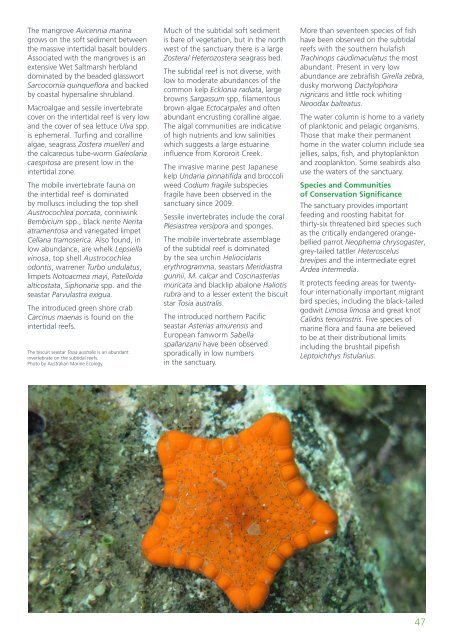Marine Natural Values Study Summary - Parks Victoria
Marine Natural Values Study Summary - Parks Victoria
Marine Natural Values Study Summary - Parks Victoria
Create successful ePaper yourself
Turn your PDF publications into a flip-book with our unique Google optimized e-Paper software.
The mangrove Avicennia marinagrows on the soft sediment betweenthe massive intertidal basalt boulders.Associated with the mangroves is anextensive Wet Saltmarsh herblanddominated by the beaded glasswortSarcocornia quinqueflora and backedby coastal hypersaline shrubland.Macroalgae and sessile invertebratecover on the intertidal reef is very lowand the cover of sea lettuce Ulva spp.is ephemeral. Turfing and corallinealgae, seagrass Zostera muelleri andthe calcareous tube-worm Galeolariacaespitosa are present low in theintertidal zone.The mobile invertebrate fauna onthe intertidal reef is dominatedby molluscs including the top shellAustrocochlea porcata, conniwinkBembicium spp., black nerite Neritaatramentosa and variegated limpetCellana tramoserica. Also found, inlow abundance, are whelk Lepsiellavinosa, top shell Austrocochleaodontis, warrener Turbo undulatus,limpets Notoacmea mayi, Patelloidaalticostata, Siphonaria spp. and theseastar Parvulastra exigua.The introduced green shore crabCarcinus maenas is found on theintertidal reefs.The biscuit seastar Tosia australis is an abundantinvertebrate on the subtidal reefs.Photo by Australian <strong>Marine</strong> Ecology.Much of the subtidal soft sedimentis bare of vegetation, but in the northwest of the sanctuary there is a largeZostera/ Heterozostera seagrass bed.The subtidal reef is not diverse, withlow to moderate abundances of thecommon kelp Ecklonia radiata, largebrowns Sargassum spp, filamentousbrown algae Ectocarpales and oftenabundant encrusting coralline algae.The algal communities are indicativeof high nutrients and low salinitieswhich suggests a large estuarineinfluence from Kororoit Creek.The invasive marine pest Japanesekelp Undaria pinnatifida and broccoliweed Codium fragile subspeciesfragile have been observed in thesanctuary since 2009.Sessile invertebrates include the coralPlesiastrea versipora and sponges.The mobile invertebrate assemblageof the subtidal reef is dominatedby the sea urchin Heliocidariserythrogramma, seastars Meridiastragunnii, M. calcar and Coscinasteriasmuricata and blacklip abalone Haliotisrubra and to a lesser extent the biscuitstar Tosia australis.The introduced northern Pacificseastar Asterias amurensis andEuropean fanworm Sabellaspallanzanii have been observedsporadically in low numbersin the sanctuary.More than seventeen species of fishhave been observed on the subtidalreefs with the southern hulafishTrachinops caudimaculatus the mostabundant. Present in very lowabundance are zebrafish Girella zebra,dusky morwong Dactylophoranigricans and little rock whitingNeoodax balteatus.The water column is home to a varietyof planktonic and pelagic organisms.Those that make their permanenthome in the water column include seajellies, salps, fish, and phytoplanktonand zooplankton. Some seabirds alsouse the waters of the sanctuary.Species and Communitiesof Conservation SignificanceThe sanctuary provides importantfeeding and roosting habitat forthirty-six threatened bird species suchas the critically endangered orangebelliedparrot Neophema chrysogaster,grey-tailed tattler Heteroscelusbrevipes and the intermediate egretArdea intermedia.It protects feeding areas for twentyfourinternationally important migrantbird species, including the black-tailedgodwit Limosa limosa and great knotCalidris tenuirostris. Five species ofmarine flora and fauna are believedto be at their distributional limitsincluding the brushtail pipefishLeptoichthys fistularius.47
















